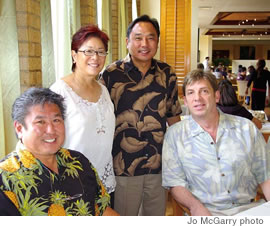Chains vs. Mom-and-pops

Wednesday - July 11, 2007
| Share
 Del.icio.us
Del.icio.us
Alan Wong, Gail Ann Chew, Paul Ah Cook and Beau
Mohr
Last week we ran part one of a discussion among industry professionals Alan Wong, Paul Ah Cook, Beau Mohr and Gail Ann Chew on the state of the restaurant industry in Hawaii. They talked about problems facing restaurants, including the influx of Mainland chains and the more recent problems of staff being “poached” from restaurants. But ultimately everyone’s concerns come down to longevity - and preserving our culture.
Here’s part two.
Beau Mohr has his own views on the problems facing restaurants. He opened Pearl at Ala Moana Center earlier this year and faced lengthy permitting procedures and construction delays.
“But I think there’s a bigger issue here, too,” he says. “I’m losing people to the city of Las Vegas, which I now consider to be competition of sorts. People are lured there by a promise of higher pay. It’s an issue I wish we could address better.”
But among the many problems facing our world-class restaurants are also concerns for an older generation of restaurant owners.
“One of the things that I’m really sad about,” says Wong, “is the closing of mom-and-pop restaurants. When you think about these restaurants, they’re our culture - where local people eat. These local restaurants run by generations of families have always been the backbone of our industry - and offshoot of our plantation heritage.”
Ah Cook agrees. As the director of operations for Desert Island Restaurants, which owns Ruth’s Chris Steak House and Macaroni Grill, he too is concerned about the loss of local restaurants.
“I hope that the chains don’t cause the closure of small restaurants,” he says. “I grew up here with so much culture, and I’d hate that to go away.”
Ah Cook and his team are well known in the industry for keeping their “Mainland chain” local, ordering local produce from farms and using fresh island fish.
And it’s not just the food that will be lost if Hawaii restaurants continue to close.
“There’s a service issue that has to be addressed,” says Gail Ann Chew. “Most of our members agree that the competition makes for a better dining experience overall, but at the same time, we’re going to be looking to restaurants to provide the same kind of service we’re used to from a momand-pop, family-run business.”
Wong agrees. “People come here for the people of Hawaii,” he says. “We have to maintain our sense of place and our identity. Any menu has to reflect the fact that you are eating in Hawaii.”
But there are more chains on the way, despite the closure recently of TGIFs, Palomino, Jackie Chan’s, and E&O Trading Company on Maui. It’s easy to see the attraction of coming to Hawaii, where name recognition rules with tourists. One need only stroll past the Cheesecake Factory in Waikiki to see that people on vacation will stand in line for a long time to eat at a place they either recognize or have heard about.
What we have to do, is to make our comfort food as comforting to the tourists as it is to us.
In much the same way as those 12 Hawaii Regional Cuisine chefs devised a plan to put Hawaii’s cooking on the map, we must now create a strategy to support our neighborhood restaurants, our local mom-and-pop places and those restaurants that support our farmers and their families. Without them, this incredibly diverse food culture we so enjoy, would never have begun - and may soon be a thing of the past.
Happy eating.
E-mail this story | Print this page | Comments (0) | Archive | RSS Comments (0) |
Most Recent Comment(s):












